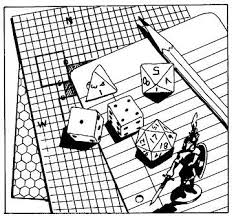Initiative in 1st-edition AD&D / OSRIC - Fundamentals & Fixes
Anyone who is familiar with the 1st edition of Advanced Dungeons & Dragons will know that there is much more to the combat round than first meets the eye.
Those coming to AD&D from original or basic versions of the game won't easily grock the game's combat, nor will those coming from later editions. This is largely, but not solely, due to the disordered presentation of the rules. I don't intend to get into the minutiae of AD&D combat here, but if you're interested, a comprehensive reordering of the rules (with references) can be found at:
https://idiscepolidellamanticora.files.wordpress.com/2012/09/addict.pdf
In this post, I'd like to take a look at the simple d6 initiative mechanic with reference to OSRIC (which in my opinion is a remarkable revision/reiteration of the 1st edition rules (and too often unfairly maligned)).
Most older editions of, or variations on, D&D simply require each side to roll a d6 to determine the order of initiative, with the highest roll going first.
In basic D&D, that's all you need to know - missile/movement, magic and melee all occur more-or-less simultaneously according to initiative order. Notably, this means you can only interrupt a spellcaster if you win initiative (spells must be declared before rolling initiative).
Rules-as-written AD&D to one side then, OSRIC is of interest because it modifies the basic system of initiative and offers a simple solution to the question of how long it takes to cast a spell in combat.
In AD&D, most spells have casting times that are counted in segments; e.g., Magic Missile has a casting time of 1 segment, and Hold Person (magic-user version) has a casting time of 3 segments. There are 10 segments in a round, a round is 1 minute long, and each segment is 6 seconds.
Now, OSRIC states that the winner of the initiative goes first but acts on the segment indicated by the die roll of the losing side (and vice versa). For example, if the party rolls a 5 and the monsters roll a 3, the party acts on segment 3 and the monsters on segment 5. A simple if somewhat confusing solution, but we'll come back to that later.
In the example above, any spell casting by the party would start on segment 3 and would finish on a later segment according to the casting time. For example, Magic Missile would take effect on segment 4, and Hold Person on segment 6. This means that Magic Missile would take effect before the monsters act on segment 5, but Hold Person wouldn't take effect until afterwards, thereby making it possible for the monsters to interrupt and spoil the spell (provided that such action was determined at the beginning of the round before initiative).
Furthermore, it's worth noting that weapon speed is ignored in OSRIC (as are the modifiers to AC according to weapon type). However, while weapon length is not specified in the rules, it does play a part in charges, which are resolved outside of the normal initiative order, with the DM being encouraged to adjudicate this according to common sense based on some simple guidelines.
For me OSRIC's version of the combat sequence preserves the simplicity of d6 initiative while including enough detail to incorporate the tactically interesting aspects of the advanced game.
Finally, returning to the reversal of the initiative dice rolls to determine which segments each side acts upon, I'd like to propose an alternative. This may be too much of a radical departure for some people, but why not have the side that rolls the lowest win initiative and act on the segment indicated by their die roll? Returning to the example above, the monsters would go first on segment 3, and the party would go last on segment 5 (and so the abovementioned spells would fall on segments 6 and 8, respectively).
I understand that my solution may not be for everyone, but I'm keen to try it out in my AD&D sessions. For me, it seems more intuitive and I have a feeling the players would grasp it quickly.


I believe that as the game was being developed, they experimented with “low roll wins” initiative. I agree it makes sense when you are trying to coordinate actions within segmented rounds. But I think that by the time the game had achieved such complexity, “high roll wins” was simply too ingrained in the game that much mental gymnastics were required to make it palatable, especially in groups that were also playing a variety of other tabletop war games which (e.g. Chainmail) which used “high-roll wins” inits.
ReplyDeleteThanks for the comment, Pious Agnostic. I'm sure you're right.
Delete